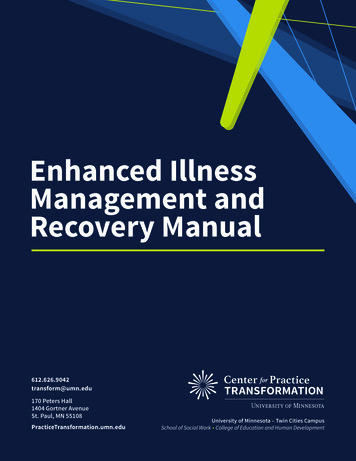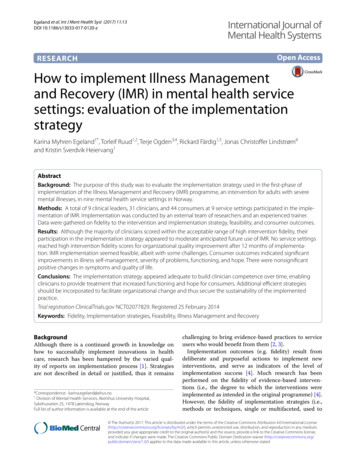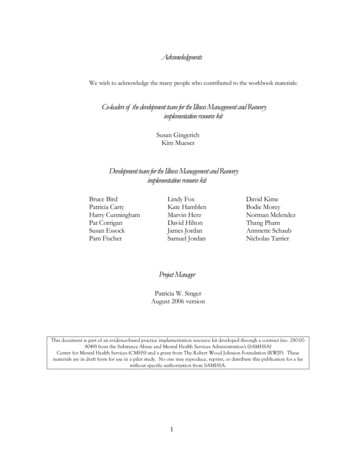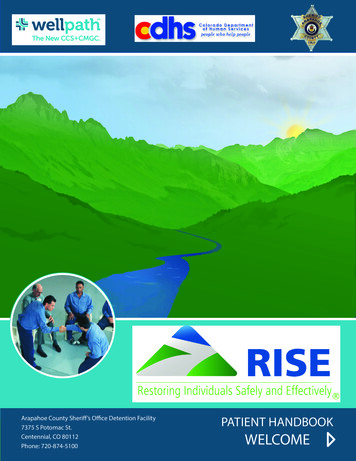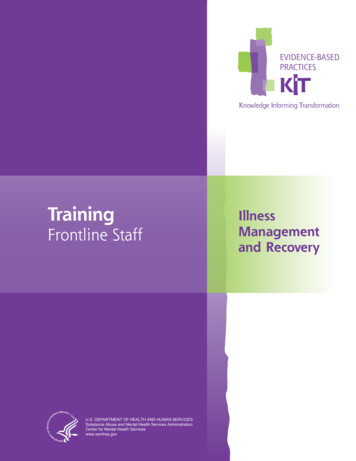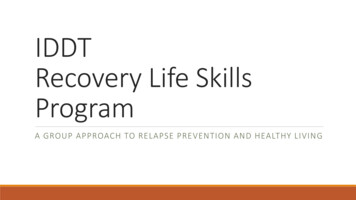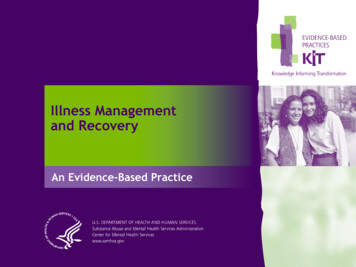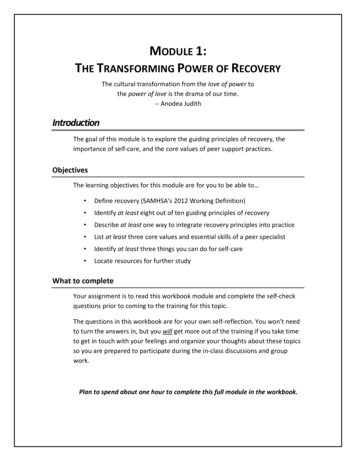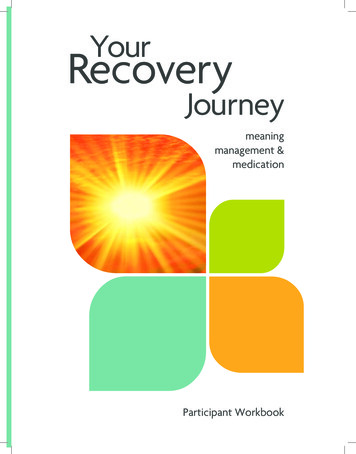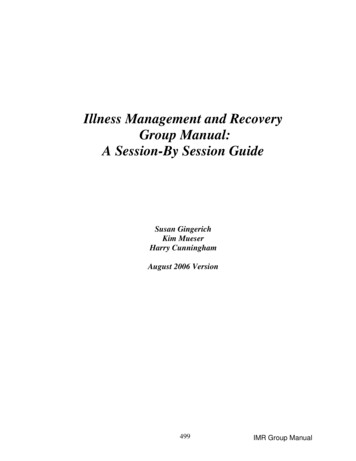
Transcription
Illness Management and RecoveryGroup Manual:A Session-By Session GuideSusan GingerichKim MueserHarry CunninghamAugust 2006 Version499IMR Group Manual
500IMR Group Manual
Table of ContentsPage numbersAN INTRODUCTION: Conducting IMR Groups. .503-507MODULE 1: STRATEGIES FOR RECOVERYIntroduction to module 509-510Session 1: The Importance of Recovery . 511-512Session 2: What Helps People in the Process of Recovery?. .513-514Session 3: Identifying Goals to Work Toward 515-516Session 4: Strategies for Achieving Goals . 517-518“Working on Goals” Worksheet . 519MODULE 2: PRACTICAL FACTS ABOUT MENTAL ILLNESSIntroduction to module . 521-522Session 1: Understanding Diagnosis, Origin, & Course of Mental Illness . 523-524Session 2: Practical Facts about Schizophrenia .525-526Session 3: Practical Facts about Mood Disorders 527-528Session 4: Public Attitudes and Behavior Toward People with Mental Illness.529-530MODULE 3: THE STRESS-VULNERABILITY MODEL AND STRATEGIESFOR TREATMENTIntroduction to module .531Session 1: What Causes Psychiatric Symptoms? .532-533Session 2: Coping with Biological Vulnerability .534-535Session 3: Understanding Treatment Options .536-537Stress-Vulnerability Diagram . 538MODULE 4: BUILDING SOCIAL SUPPORTIntroduction to module .539-540Session 1: Why is Social Support Important? .541-542Session 2: Meeting New People .543-544Session 3: Starting a Conversation with Someone New, Part 1 .545-546Session 4: Starting a Conversation with Someone New, Part 2 .547-548Session 5: Things You Can Say to Develop Closer Relationships .549-550Session 6: Things You Can Do to Develop Closer Relationships, Part 1 551-552Session 7: Things You Can Do to Develop Closer Relationships, Part 2 553-554MODULE 5: USING MEDICATIONS EFFECTIVELYIntroduction to module 555-556Session 1: The Role of medication in Managing Symptoms . .557-558Session 2: Identifying and Responding to Side Effects . .559-560Session 3: Making Informed Decisions About Medication . .561-562Session 4: Getting the Best Results from Medication . .563-564501IMR Group Manual
MODULE 6: DRUG AND ALCOHOL USEIntroduction to module .565-566Session 1: Understanding Drug and Alcohol Use 567-568Session 2: Substance Use and the Stress Vulnerability Model 569-570Session 3: Weighing the Pros and Cons of Sobriety 571-572Session 4: Developing a Sober Lifestyle .573-574Session 5: Making a Personal Sobriety Plan 575-576Session 6: Revising your Personal Sobriety Plan and Putting it into Action .577-578MODULE 7: REDUCING RELAPSESIntroduction to module .579-580Session 1: Identifying Triggers of Relapse .581-582Session 2: Early Warning Signs of Relapse .583-584Session 3: Responding to Signs & Symptoms of Relapse .585-586Session 4: Developing a Relapse Prevention Plan .587-588MODULE 8: COPING WITH STRESSIntroduction to module .589-590Session 1: What Causes Stress? .591-592Session 2: Recognizing Signs of Stress .593-594Session 3: Preventing Stress 595-596Session 4: Coping with Stress using Relaxation Techniques .597-598Session 5: Additional Strategies for Coping with Stress .599-600MODULE 9: COPING WITH PROBLEMS AND PERSISTENT SYMPTOMSIntroduction to module .601-602Session 1: A Step-By-Step Model for Problem Solving and Goal Achievement.603-604Session 2: Identifying Common Problems and Persistent Symptoms .605-606Session 3: Using the Problem Solving Model with a Problem or Persistent 607-608SymptomSession 4: Developing a Plan to Cope with a Common Persistent Symptom .609-610Session 5: Developing a Plan to Cope with Another Common Persistent .611-612SymptomSession 6: Developing a Plan to Cope with a Personal Persistent Symptom .613-614MODULE 10: GETTING YOUR NEEDS MET IN THE MENTAL HEALTHSYSTEMIntroduction to module .615-616Session 1: Community Mental Health Services that Might be Helpful to You.617-618Session 2: Financial and Health Insurance Benefits that You May Be Entitled.619-620Session 3: Advocating for Yourself in the Mental Health System .621-622Appendix:Educational Handout #2,"Practical Facts About Mental Illness",(Adapted for group).623-650502IMR Group Manual
Introduction;Conducting IMR GroupsAdvantages of Different FormatsIMR can be provided using either an individual or group format. Each format hasits advantages. The primary advantages of the individual format are that teaching ofmaterial can be more easily paced to meet the person’s needs, and more time can bedevoted to addressing his or her specific concerns. The main advantages of the groupformat are that it provides people with more sources of feedback, motivation, ideas,support, and role models. Teaching IMR in a group format may also be more economical.Offering IMR in a group is especially advantageous because it provides the opportunityfor peer support to develop: consumers helping other consumers. Peer support can helpmotivate and prolong the attention of consumers. Finally, role-playing and problemsolving in a group setting enriches the learning experience, because several good ideasand solutions are likely to be generated.The advantages of doing IMR in a group are significant, but group leaders mustbe aware of certain challenges in this format. The chief among those is the difficulty insetting a reasonable pace for teaching the material within each of the IMR modules. Gotoo fast and you lose those consumers who struggle to maintain attention, have memoryimpairments, or need extra time to understand the steps involved in learning specificskills. Go too slow and you risk boring those consumers who need to be challenged andstimulated at a quicker pace. Being able to balance the pace so that it is reasonable for allmembers is a group leader’s skill that needs to be constantly honed. Another challenge isthe difficulty of maintaining an ongoing focus on each member’s goals. A concentratedeffort by group leaders is needed to help keep each member’s “eye on the prize” in amanner that does not become routine. Finally, actively involving family members andother supporters into the IMR practice is more challenging when a group is used. (Seethe section below, “Involvement of Significant Others,” for suggestions to includesupporters.)Some programs provide IMR with a combination of group sessions and one-toone sessions in order to offer the best of both worlds. The individual work is seen as asupplement to the group. Practitioners meet with a consumer every 1-4 weeks to supportthe learning and skill-building being done in the group, and also to work with theindividual on making progress towards his or her personal goal(s).PreparationIn order to assist practitioners in conducting IMR groups as smoothly as possible,various aspects of running a group practice will be discussed. This section supplementsbut does not replace the material contained in Chapter 1 (“The Basics of IllnessManagement and Recovery”) of the IMR “Practitioners and Clinical Supervisors503IMR Group Manual
Workbook.” Reading that chapter is strongly recommended as a preparation to doingIMR in either an individual or a group format.It is not expected that the group leaders will read the Practitioner Guidelines,Educational Handouts, and Group Leader’s Guidelines for all of the IMR modules beforethey start doing IMR, although there are benefits to doing so. Practitioners cansuccessfully learn the practice by thoroughly reading each set of Practitioner Guidelines,Educational Handouts, and Group Leader’s Guidelines in preparation for doing a specifictopic area. The Group Leader’s Guidelines are especially helpful because they providesuggestions for each session spent on the educational handout, including motivational,educational, and cognitive-behavioral strategies and home assignment ideas. The sessionstructure shown in the following table should be followed for best results, although theremay be occasions when the group temporarily shifts from that structure.Steps of Leading IMR Group SessionsStepTime1. Informal socializing (greeting & welcomingmembers)2. Review the previous session.3. Review home assignments.1-2 minutes4. Follow up on the goals of 2-3 members.5. Set agenda for the session.6. Teach new materials. Include practice of newstrategies or skills.7. Agree on individual home assignments to becompleted before the next session.8. Summarize progress made in the session.1-3 minutes5-10minutes5-10minutes1-2 minutes20-25minutes5-10minutes3-5 minutesThe average length of a group session is usually 45 minutes to 1-1/2 hourAs the group starts each new module, members are given their own copy of eitherthe whole educational handout or the pages that will be covered in that session. GroupLeaders are encouraged to obtain 3-ring binders or sturdy folders for each group memberto keep their set of handouts. Some IMR group members have difficulty remembering tobring their materials to group or lack a secure place to keep their materials at home, andappreciate the option of leaving their notebooks or folders in the group room or in a safeplace elsewhere in the agency. Our experience has also shown that it helps to have extracopies of educational handouts available for those members who forget to bring their owncopy. Those extra copies can then be collected at the end of group.504IMR Group Manual
General Group GuidelinesA minimal number of general group guidelines are helpful. Here are some commonguidelines:- What is said in the room stays in the room.- All participants and property should be treated with respect.- Regular attendance is expected. Leaders should be notified when someone isunable to attend.Violations to the guidelines can be dealt with in various ways. Less serious onescan be raised in a general way, not by confronting a specific member, but by remindingall members of the guideline and asking for a recommitment to it. More seriousviolations can be dealt with by having specific members meet separately with groupleaders. Only in the most extreme situations should a member be confronted in front ofother group members.Tracking GoalsAs stated earlier, one of the challenges to doing IMR in a group format is thedifficulty of routinely following the goal progress of each member. It is important tomaintain an ongoing level of monitoring on several aspects of goal progress: breakingdown goals into small steps, recognizing movement towards specific goals, helpingconsumers make occasional adjustments to desired goals, and setting new goals when oldones have been reached. The motivation for consumers to strive for recovery is oftenlinked to their desire to reach for those things that give meaning to their life.Step #4 in each group session is intended to follow up on 2-3 members’ goals.Focusing on different members each week on a rotating basis will lead to ongoingattention to goal progress. Some group leaders initiate applause when progress has beenmade and give out awards for specific milestones being reached. The use of some formof tracking sheet is recommended to aid this process. The “Goals Set in the IMRProgram” sheet that is located in Educational Handout #1(“Recovery Strategies”) workswell for that purpose. Also, keeping current copies of each member’s “Working onGoals” sheets in a combined 3-ring binder is a an effective way to track the goals of theentire group.Flexibility in IMRAn evidence-based practice such as IMR is not intended to be implemented as a“cookbook” treatment in which the practitioner does specified interventions in a rotemanner. Instead, practitioners are encouraged to use the clinical expertise that they havedeveloped over their years of experience to help inform them about how to best use thestructure of IMR. An additional ingredient that drives the practice is consumerpreference. For example, assessing that many group members are at an early stage oftrying new skills to move toward recovery, the practitioner might temporarily slow downefforts at following the curriculum and spend more time encouraging members to505IMR Group Manual
contemplate how their life would be different if they worked on desired goals. Weighingout the pros and cons of change at that moment might be a more effective strategy thanpushing ahead with the curriculum when members are uncertain of taking risks. Thisintegration of clinical knowledge, consumer preference and research knowledge shouldbe a goal of practitioners; none of those qualities alone guides a practitioner towardeffective interventions.Home AssignmentsThe purpose of having home assignments is for members to learn the skills thatare being taught in each session and to put them into practice in their own environment.Generally a group leader asks for all members to share the results of their homeassignments at the beginning of each group session. A common way to begin is to ask fora volunteer to discuss their practice experience and then to go around the circle. Beaware that some members will be fine with the term “home assignment” while othersmay feel uncomfortable with it. Group leaders can use different terminology, such as“something to follow up what we talked about in group today,” “opportunity to practicewhat we’re learning,” or “recovery action steps.”Leaders should expect, but not accept, that many members will not do their homeassignments or struggle to complete them. For some members, this is a new expectationof treatment that will take time and effort getting used to. Others may not believe it is avital part of learning new skills. Leaders will be rewarded for their efforts at consistentlyexpecting that assignments be attempted. Measures to help improve the completion ofassignments include carefully tailoring the assignment with each group member, praisingall efforts at doing home assignments, analyzing and problem-solving any difficulties indoing assignments. For example, it’s important for group leaders to explore with thegroup members what got in the way of doing the assignment. Group leaders can helpmembers identify the barriers and problem solve a more effective outcome. Use shaping,by praising taking small, but real steps toward doing home assignments. Carrying out arigorous analysis of a member’s homework difficulties will lead to those member’s betterbeing able to use IMR skills in the real world.Role-playsThe use of role-plays to learn and practice new skills is an invaluable way forconsumers to integrate IMR skills into their daily life. Some people may feel vulnerableor shy when doing role-plays in front of others. Group leaders can prevent or minimizethe risk of group members having an unpleasant experience role-playing by structuringthe role-plays and following them with discussion that always starts with noticing whatthe person did well in the role-play. Some suggestions include making role-plays anexpectation of participation, but to be willing to shape reluctant member’s participation ata pace that is dictated by the situation. Asking reluctant members to first role-play with agroup leader sometimes works. Following each role-play, praise the positive aspects ofthe performance. Be gentle in the “corrective” portion of the process, and generalizecriticism whenever possible. For example, “Most of us find it hard to make eye contact506IMR Group Manual
at first. It usually gets easier with practice. Let’s try that again.” Criticism should belimited and have the goal of shaping a specific step toward the desired behavior, ratherthan a list of all the things that the member should improve. One “corrective” suggestionper role-play goes a long way. The leaders should think along the lines that “Romewasn’t built in a day.”Involvement of Significant OthersThe involvement of significant others in IMR is viewed as an important principleof the practice. Family members and other supporters of a consumer are often valuableallies on the way toward recovery. Practitioners are encouraged to look for creative andproductive ways to involve significant others in the IMR work. Targeting a limitednumber of specific sessions to have supporters attend is one possibility, such as ones thatfocus on forming a relapse prevention plan, or on understanding the diagnosis, or onunderstanding the stress-vulnerability model. Another idea is to hold a limited number ofone-to-one supplemental sessions between practitioner, consumer and family member.Focus could include efforts to complete a relapse prevention plan, or to discuss adiagnosis, or to learn a specific medication-taking skill. Targeting a level of activeparticipation outside of group could also help. Encouraging the consumer and supportperson to read the educational handouts together at home, or engaging the supporter tohelp with home assignments are also effective forms of encouraging participation bysignificant others. Another idea is to have a “Friends and Family IMR Support Group”which meets monthly, reviewing the modules that are currently being worked in thegroup sessions, and providing suggestions for how family members can support what isbeing learned in the group.Closing CommentsMany consumers report that participating in IMR in groups has been extremelybeneficial. They describe feeling supported by peers when they are learning information,strategies and skills, and being inspired by hearing others talk of their own experienceswith moving forward in recovery. Practitioners report that IMR groups present anopportunity for them to motivate and encourage consumers to takes steps towardsrecovery in ways that are not possible in a one-to-one format. Practitioners also reportbeing energized by the increased focus on recovery and the strong sense of hope thatdevelops in IMR groups.507IMR Group Manual
508IMR Group Manual
Group Session Guide for Handout #1:Recovery StrategiesSession 1:Session 2:Session 3:Session 4:The Importance of RecoveryWhat Helps People in the Process of RecoveryIdentifying Goals to Work TowardStrategies for Achieving GoalsIntroduction:Recovery Strategies sets a positive and optimistic tone that is continued throughout theIllness Management and Recovery Program. The group leaders conveys confidencethat people who experience psychiatric symptoms can move forward in their lives. Theconcept of “recovery” is introduced and people are encouraged to develop their owndefinitions of recovery and to develop personal strategies for taking steps towardsrecovery. By the end of working with the group using the Recovery Strategies Handout,the leader has helped people to establish personally meaningful goals that will befollowed up throughout the program.Overall Goals:For members to increase their awareness of the concept of recovery and toexpand the possibilities of recovery in their own life.To learn common activities that people use to help themselves. To increasethe ways each member might choose to help his/her own recovery.Members begin to set goals that they will work on.Members begin to develop a specific plan for achieving one or two personalgoals.509IMR Group Manual
Steps of Leading IMR Group SessionsStepTime1. Informal socializing (greeting & welcomingmembers)2. Review the previous session.3. Review home assignments.1-2 minutes4. Follow up on the goals of 2-3 group members.5. Set agenda for the session.6. Teach new materials. Include practice of newstrategies or skills.7. Agree on individual home assignments to becompleted before the next session.8. Summarize progress made in the session.1-3 minutes5-10minutes5-10minutes1-2 minutes20-25minutes5-10minutes3-5 minutesThe average length of a group session is usually 45 minutes to 1-1/2 hours510IMR Group Manual
Handout 1: Recovery StrategiesSession 1: The Importance of RecoveryTopic headings in Handout 1: Introduction What is Recovery?Session Goal: Members will increase their awareness of the concept of recovery andexpand the possibilities of recovery in their own life.1. Informal socializing. (Greetings, welcoming people to group).2. Briefly review last session. Ask members what they thought were the most importantpoints and whether they have any questions. (Not applicable in the first session of thegroup.)3. Review home assignments. (Not applicable in the first session of the group.)4. Follow up on group members’ goals. (Not applicable in the first session of thegroup.)5. Set the agenda for today’s session. “Today we’re going to talk about recovery from mental illness and what it meansto different individuals.”6. Teach material from the handout.Motivational teaching strategies: Help members make the connection between members being hopeful andrecovery-oriented, and being able to achieve their goals.Educational teaching strategies: Summarize the main points or ask members to take turns reading topicareas. Encourage discussion of main points. Ask the discussion questions provided in the text. Prompt members to relate material to their own lives. Check frequently for understanding.Opportunities for cognitive-behavioral teaching strategies: Members are encouraged to circle personally meaningful quotations fromEducational Handout #1as they are read/discussed.511IMR Group Manual
7. Ask group members to do a home assignment related to the topic. The groupleader should suggest a general assignment. Check with members to assist them, ifnecessary, to tailor the assignment to their skill and confidence levels. For example,it may be more realistic for some members to do only part of the assignment or ascaled down version of the assignment. It is helpful for members to select the bestday, time, location, etc. to do the assignment. Ideas for general home assignments arelisted below: Write down brief ideas of what recovery means to you and bring it to the nextsession. Review the handout material with a significant other or staff member.8. Summarize the progress made in today’s session. Praise all efforts. “We talked about a lot of things today. What do you think were some of the mainpoints? What was helpful to you?” “People in the group did a great job today. I look forward to seeing you all in ournext group.”512IMR Group Manual
Handout 1: Recovery StrategiesSession 2: What Helps People in the Process of Recovery?Topic Heading in Handout 1: What Helps People in the Process of Recovery?Session Goal: To learn common activities that people use to help themselves. Toincrease the ways each member might choose to help his/her own recovery.1. Informal socializing (Greetings, welcoming people to group)2. Briefly review last session. Ask members what they thought were the most importantpoints and whether they have any questions.3. Review home assignments. Praise all efforts. Analyze and problem-solve anydifficulties in doing assignments. See what got in the way: did they forget, did theyremember but were unmotivated, did they attempt it but were frustrated, did they do it butdid not experience any benefits? Identify the barriers and attempt to problem solve amore effective outcome. Use shaping. (Praise members for taking small steps towarddoing effective homework.)4. Follow up on group members’ goals. (Not applicable as goal setting has yet to becovered.)5. Set the agenda for today’s session. “Last week we talked about what recovery means to different individuals. Todaywe’re going to talk about what helps people in the process of recovery.”“Some people may have already identified what helps them in the process ofrecovery. I would appreciate it if those members could share what they haveidentified as we go along.”“How might it be useful to us to learn some strategies for moving forward inrecovery? How could making progress in recovery be helpful in pursuing ourgoals?”6. Teach material from the handout.Motivational teaching strategies: Encourage group members to connect making progress in their recoveryprocess to achieving goals that are important to them.513IMR Group Manual
Educational teaching strategies: Summarize the main points or ask members to take turns reading topicareas. Encourage discussion of main points Ask the discussion questions provided in the text. Prompt members to relate material to their own lives. Check frequently for understanding.Opportunities for cognitive-behavioral teaching strategies: Group members can be asked to circle or check off personally meaningfulstrategies, as they are read/discussed.7. Ask group members to do a home assignment related to the topic. See theinstructions for item #7 of Session 1 of this module for guidelines about how to tailor ageneral assignment to the individual group member. Possible general assignmentsinclude: Complete the checklist “Strategies for Recovery.” Review the handout material with a significant other or staff member.8. Summarize the progress made in today’s session. Praise all efforts. “We talked about a lot of things today. What do you think were some of the mainpoints? What was helpful to you?” “People did a great job today. I look forward to seeing you all in our next group.”514IMR Group Manual
Handout 1: Recovery StrategiesSession 3: Identifying Goals to Work TowardTopic headings of Handout 1: What’s important to you? What goals would you like to pursue?Session Goal: Members begin to set goals that they will work on.1. Informal socializing (Greetings, welcoming people to group).2. Briefly review last session. Ask members what they thought were the most importantpoints and whether they have any questions.3. Review home assignments. Praise all efforts. Problem-solve any difficulties.4. Follow up on members’ goals. (Not applicable as goal setting has yet to be covered.)5. Set the agenda for today’s session. “Last week we talked about strategies that help people in the process of recovery.Today we’re going to talk about what we would like to see happen in our lives aswe move forward in recovery. This is the beginning of setting goals we wouldlike to work towards.”“Some people may have already identified areas of their lives they would like tobe different as part of their recovery. I would appreciate it if some of you couldshare the goals you have set with the rest of the group.”6. Teach material from the handout.Motivational teaching strategies: Encourage group members to make the connection between being able toidentify what’s important to them in life and being able to set goals.Educational teaching strategies: Summarize the main points or ask members to take turns reading topicareas. Encourage discussion of main points. Ask the discussion questions provided in the text. Prompt members to relate material to their own lives. Check frequently for understanding.515IMR Group Manual
Opportunities for cognitive-behavioral teaching strategies: Begin to shape members to think about the importance of taking smallsteps toward goals, in contrast to a mistaken belief that success is “all ornothing.”7. Ask group members to do a home assignment related to the topic. See theinstructions for item #7 of Session 1 of this module for guidelines about how to tailor ageneral assignment to the individual group member. Possible general assignmentsinclude: If there was not time during group, complete the checklist “Satisfaction withAreas of My Life.” Select one or two areas of your life that you are not satisfied with and which youwould particularly like to start working on. Use the chart “Goals set in the IllnessManagement and Recovery Program” to list those one or two areas as goals thatyou would like to set for yourself. Review the handout material with a significant other or staff member.8. Summarize the progress made in today’s session. Praise all efforts. “We talked about a lot of things today. What do you think was the main point orsome of the main points? What was helpful to you?” “You did a great job today. I look forward to seeing you all at our next group.”516IMR Group Manual
Handout 1: Recovery StrategiesSession 4: Strategies for Achieving GoalsTopic headings of Handout 1: What are some strategies for achieving your goals? What goals would you like to focus on?Session Goal: Members begin to develop a specific plan for achieving one or twopersonal goals.1. Informal socializing (Greetings, welcoming people to group).2. Briefly review last session. Ask members what they thought were the most importantpoints and whether they have any questions.3. Review home assignments. Praise all efforts. Problem-solve any difficulties.4. Follow up on the goals of 2-3 members on a rotating basis so that the progress ofeach member is routinely updated. Group members may still be at the very early stages of identifying and makingplans to achieve goals. However, if some group members have established goals,ask 2-3 of them what is happening regarding their goals. Provide encouragement.5. Set the agenda for today’s session. “Last week we talked about setting some goals in the IMR program to improveareas of our lives we are not satisfied with. Today we we’re going to work atbreaking down those goals into smaller steps.”“How might it be useful to us to make a plan related to achieving goals? Whatmight be some advantages for planning versus starting immediately and figuringit out as we go?”“You should expect that snags would come up that get in the way of workingtoward goals. We will look at ways to find solutions to those obstacles.”6. Teach material from the handout.Motivational teaching strategies: Help group members mak
but does not replace the material contained in Chapter 1 (“The Basics of Illness Management and Recovery”) of the IMR “Practitioners and Clinical Supervisors . Workbook.” Reading that chapter is strongly recommended as a preparation to doing IMR in either an individual or a group f
